|
The area known as Old Town which spreads up the hill and overlooks the harbour is what remains of the old town of Barmouth. Before the middle of the 19th century the whole town consisted of buildings of this more traditional style. The lanes that crawl up from the town's main streets in a most haphazard way will soon have you gazing down over the town, the estuary and the bay in just a few minutes (give or take a few breathers!)
Continue up beyond the cottages and you will eventually come to the National Trust Information Board and this explains that the area you stand in, Dinas Oleu, was the first parcel of land to be given to the then newly formed Trust by Mrs. Fanny Talbot
Among the cottages in Old Town are several that were given, for a consideration of £1000, by Fanny Talbot to John Ruskin and his Guild of St. George in 1874. These were to house the poor as part of Ruskin's social experiment, outlined in his Fors Clavigera, that aimed to prevent the foment of revolution.
One of the tenants 'acquired' with these cottages was a Frenchman , Auguste Guyard, exiled after he had fallen out with the authorities in his homeland. He was certainly a kindred spirit of Ruskin. He created extensive gardens on this inclement rock and is buried above his cottage (below) in what has become known as the Frenchmen's Grave.
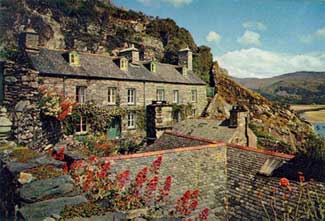
Rock Cottages in Old Barmouth
|
|
|
|
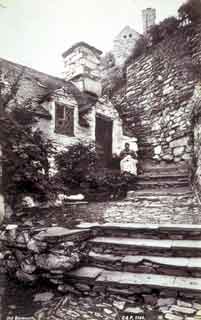 |
|
|
|
Gibralter Cottage - Old Barmouth |
|
|
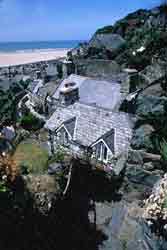 |
|
|
|
Looking over Ruskins'cottages |
|
|
|
Ty Gwyn, located on the quayside, is a first floor hall house, and is described in a poem by Tudur Penllyn (circa 1420-1490). It was said to be used by Jasper Tudor, Earl of Pembroke, uncle of the future king Henry VII, to meet local supporters while plotting the overthrow of the Yorkists during the Wars of the Roses. It has an interesting butt tenoned purlin roof and houses an exhibition on its origins and the seafaring history of the town. |
|
|
|
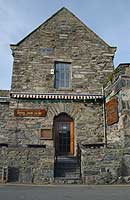 |
|
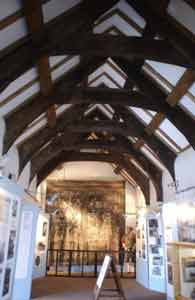 |
|
|
|
Medieval Ty Gwyn |
|
|
|
Also on the quay is the Sailor's Institute, founded at the end of the 19th century to provide a reading and meeting room for the mariners of the town. The Institute stills meets regularly.
Its unprepossessing exterior, once a Victorian corrugated iron clad building, houses an attractive original interior with a variety of material about the maritime development of Barmouth.
|
|
|
|
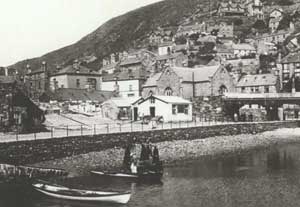 |
|
|
|
 |
|
|
|
Sailor's Institute circa 1895 |
|
|
|
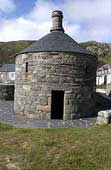 |
|
|
|
Just behind the quay is Barmouth's old lock-up called Ty Crwn or the Round House. Built during the 1830's as the town's gaol - at a cost of £55. It must have been widely used to accommodate the inebriated and/or troublesome of the town. |
|
|
|
Ty Crwn |
|
| Also on the quayside, one last visit will take you to the Lifeboat Museum. Once a house called Pen-y-Cei it is now solely used to exhibit information about the history of the lifeboat service that has played such an important role in saving lives off the coast of Ardudwy. |
|
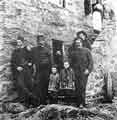 |
|
 |
|
|
Harbour Master's Office |
|
|
|
There are some interesting churche's & chapels in Barmouth. Most of the latter are now enjoying a different use, mostly as retail outlets and one is used as a theatre while the churches still carry on with a fraction of the congregations they once accommodated. St.David's is the earliest church (1830) in the town while St. John's is the most impressive, despite its tower collapsing into the nave upon completion in 1893 and having to be rebuilt. It opened for worship in 1895.
|
|
|
|
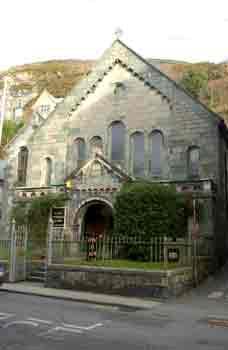 |
|
|
|
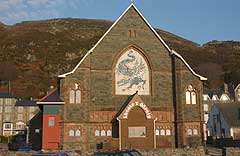 |
|
|
|
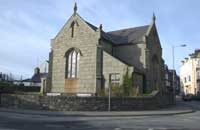 |
|
|
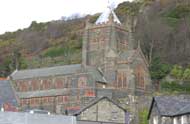 |
|
|
|
Just 2 miles north of Barmouth is an early medieval church. St. Mary's, a beautifully located building overlooking the bay. Built in the early 13th century by Hywel ap Meredith ap Cynan, Lord of Ardudwy on a site already used in the 6th century, established by St. Bodfan.
There is a fine mid-15th century roof over the nave. The church was extensively rebuilt on the east gable during the 19th century
|
|
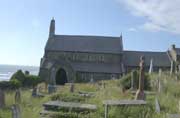 |
|
|
|
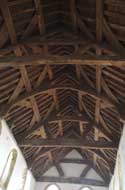 |
|
|
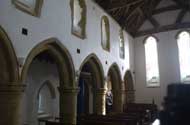 |
|
|
|
St. Mary's Church, Llanaber |
|
|
|
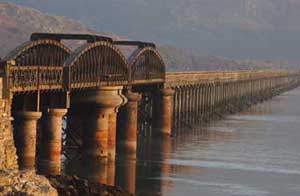 |
|
|
From Barmouth, its easy to venture further afield. By foot a stroll across the tollpath on Barmouth Bridge, built in 1867 and now a Grade II* listed structure, will lead you onto the most beautiful walk along the river. It runs along the bed of the old railway, a victim of Beecham's 60's decimation of the railways. A 5-6 mile walk will reward you with splendid refreshment at the George III Hotel at Penmaenpool. You can the make your way back then! |
|
|
|
Barmouth Bridge |
|
|
|
back.. |
|
|
|
|
|
|
|
|
|
|
|
|
|
|
|
|
|
|
|
|
|
|
|
|
|
|
|
|
|
|
|
|
|
|
|
|
|
|
|
|




